What Metals Are Your Favorite Sports Trophies Made From?
With the NHL and the NBA playoffs in full swing, it won’t be long until one team from each sport lifts the championship trophy over their heads, for all the world to see. Most of the trophies for the major sports in North America are made of precious metals, such as silver and gold, and specially crafted by artisans each year. Here’s a backgrounder on the most prized hardware in American sports.
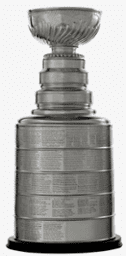
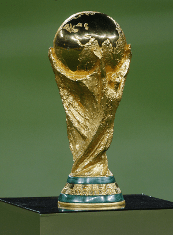
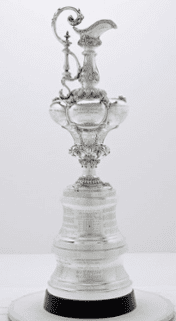
The best-known trophy in American sports today is likely to be the Heisman Trophy. It is named after John Heisman, a multi-sport athlete and coach and one-time athletic director of the Downtown Athletic Club (DAC), of New York City. The DAC began presenting the award in 1935 to “the outstanding college football player whose performance best exhibits the pursuit of excellence with integrity.” Some of the most famous college players in American football history (such as Roger Staubach, O. J. Simpson, Tony Dorsett, Doug Flutie, Tim Tebow, and Johnny Manziel) have won the award. The DAC commissioned sculptor Frank Eliscu to design the award as a statue in the form of a running football player. Eliscu modeled the statue after an outstanding player he knew from New York University. Once completed in clay, Eliscu then turned to the metalworking firm of Dieges & Clust, in New York, which used the lost wax process to cast the statue in bronze. It measures 14 inches in length, 13.5 inches in height, and 6.5 inches in width, and weighs in at 45 pounds. New statues are created every year, most recently by Roman Bronze Works, in New York. In 2001, the DAC was damaged in the September 11 terrorist attack in New York City, which caused the club eventually to disband. The award is now administered by the Heisman Trust.
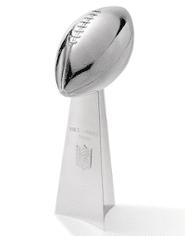

As mentioned above, the NBA playoffs are underway; and by June 20 at the latest one team will be able to hoist the Larry O’Brien NBA Championship Trophy. This trophy is named in honor of former NBA commissioner Larry O’Brien, who served from 1975 to 1984 and led the effort to merge the ABA into the NBA. It is the successor to the original NBA championship award, the Walter A. Brown Trophy since 1984. The new trophy, standing two feet tall, depicts a basketball teetering above a hoop. It’s made of 14.5 pounds of sterling silver and vermeil with a 24-karat gold overlay. Valued at $13,500, the trophy is produced by the Tiffany & Co. silver shop every year for the winning team to keep.
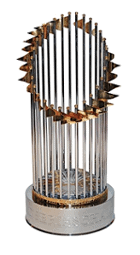
While folks today may not realize this, horse racing was once the most popular sport in North America. The most celebrated stakes race of them all, the Kentucky Derby, still commands media attention every May due to its long, rich history. Known as the “The Most Exciting Two Minutes in Sports,” the race has been contested every year since 1875. The Kentucky Derby Trophy was designed in 1924, for the 50th running of the race, by artist George L. Graff, of Toledo, Ohio. Since 1975, the trophy has been manufactured by New England Sterling, of North Attleboro, Mass. It stands 22 inches in height and weighs 56 ounces, not counting its jade base. The trophy (valued at about $900,000) is handcrafted with the exception of the 18-karat horse and rider, which are both cast from a mold, according to the race’s organizers. Only two major changes have been made to the solid-gold trophy over the years. A decorative horseshoe was turned to point upward in 1999, as racetrack lore held that a downward pointing horseshoe signified bad luck. And as of this year, the statuette of the horse has been encrusted with more than 300 rubies to emulate the blanket of flowers the winning horse receives every year for conquering the “Run for the Roses.”
While not technically trophies, the most celebrated use of metals in sports is undoubtedly that of the medals awarded to the first-, second-, and third-place finishers in the events of the Olympic Games, the world’s foremost sports competition. At the first games of the modern Olympics, held in Athens in 1896, first-place finishers received silver medals, second-place finishers received bronze medals, and all finishers received a commemorative medal. The traditional gold-silver-bronze order was first instituted at the 1904 St. Louis Games. Since then, the medals have come in multiple designs, sizes, and weights, determined by the International Olympic Committee in concert with the host nation. Still, some uniformity eventually prevailed. The IOC has developed the following guidelines: A minimum of 60 millimeters in diameter; minimum of 3 mm thickness; first-place medal composed of silver (at least .925 grade) covered with 6 grams of pure gold; second-place medal has the same composition as the first place medal without the gilding; third-place medal is mostly copper with some tin and zinc (bronze). The Olympic committee of the host nation typically sees to the minting of the medals (e.g., the Royal Mint for the 2012 Games in London).
Other notable sports trophies include:
-
Tennis – The Championships Wimbledon: Gentlemen’s Singles Trophy, first presented by the All England Club in 1887, is made of silver gilt, stands 18 inches high, and has a diameter of 7.5 inches. The Ladies’ Singles Trophy, a silver salver, was first presented in 1886. It is made of partly gilded sterling silver (18.75 inches in diameter).
-
Tennis – U.S. Open (Tennis): The Men’s Championship Trophy is made by Tiffany & Co. from sterling silver; the front of the cup features some of the most famous names in tennis history.
-
Golf – The Open Championship: The famed silver Claret Jug (or the Golf Champion Trophy) was originally produced in 1873 by Mackay Cunningham & Co., of Edinburgh. The champion receives a replica. Famous Americans such as Bobby Jones, Walter Hagan, Jack Nicklaus, and Tiger Woods have won Claret Jugs over the years.
-
Golf – U.S. Open Championship Trophy: This distinctive sterling silver loving-cup-style trophy was first presented in 1895 and was passed from winner to successive winner until 1946, when it was destroyed in a fire. Nevertheless, the USGA commissioned an exact duplicate, which now rests in a museum. Winners receive replicas.
-
Soccer – The Copa America Trophy: Sort of the World Cup of the Americas, this international association football competition has been held every four years since 1916. And since 1993, it has been open to North American invitees. The next championship, in 2016, will be held in the U.S. Designed by a jewelry shop in Buenos Aires, the trophy is a silver ornament that rests on a base of plaques.






